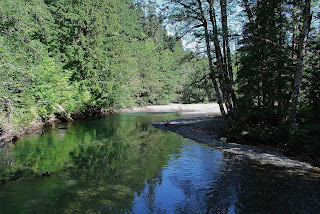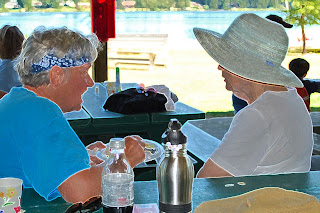When we stopped, the silence was absolute.
Walking, the only sounds were the soft footfalls of our
boots on the path and the tap, tap of
our walking sticks.
Covering the open, grassy
hillside - both above and below us - swayed an array of wildflowers...
blue
yellow
red
pink
purple
white
Up the hill, a few pointed firs and the stark, bleached
remains of large dead trees scattered across the open landscape. These, reflecting
a long-ago fire and many, many years of severe weather.
Far below, the
White River flowed briskly downward, row after row of rugged peaks forming a
receding backdrop.
Behind us, and seemingly close enough to touch, the mighty
Mount Rainier dominated all. Ascending to 14,410 feet above
sea level, this huge monolith stands as an icon in the western Washington
landscape.
An active volcano, it is the most glaciated peak in the contiguous U.S., and spawns six major rivers.
Subalpine wildflower meadows ring this icy volcano while ancient forest cloaks its lower slopes. It is a magnificent sight to behold and truly a work of art, but it has not always been such.
Formed through eons of change within the earth's crust, today's Rainier is the product of uplift, erosion, volcanic action, and time.
The early lava deposits are estimated to be more than 840,000 years old.
The summit is topped by two volcanic craters, each more than 1,000 feet in diameter. Geothermal heat from within keeps parts of both crater rims free of snow and ice and has formed the world's largest volcanic glacier cave network within the ice-filled craters, with nearly 2 miles of passages.
Mt. Rainier is considered one of the most dangerous volcanoes in the world. Because of its large amount of glacial ice, it could potentially produce massive lahars (volcanic mudflows) that would threaten the whole Puyallup River valley.
Northwest American Indians knew this mountain long before European explorers reached the Pacific.
Yakama, Puyallup, Nisqually, Cowlitz and Klickitat fished and hunted in the lowlands surrounding the mountain; hunting parties followed game up the slopes as the winter snows retreated.
For generations they revered and knew it as Takhoma, Talol, Tahoma, Ta-co-bet and several other names.
Many of the names mean 'The mountain that was god', 'big mountain', 'snowy peak', 'mother of waters' or 'place where the waters begin.'
The city of Tacoma takes its name from one of the original native names for Rainier. Indeed, this ancient volcano can be seen throughout the greater Puget Sound area and on an exceptionally clear day is visible from Portland, Oregon to Victoria, British Columbia.
The outward appearance of this geologic wonder belies the
tremendous power and fury that lie below. It is a reminder that constant change
is a given, things are not always what they seem, and that appearances can be
deceiving. In one way or another, all of us here live in the shadow of what is
- in a superlative sense -
The
Mountain.
He
said, "Go out and stand on the mountain before the LORD, for the LORD is
about to pass by." Now there was a great wind, so strong that it was
splitting mountains and breaking rocks in pieces before the LORD, but the LORD
was not in the wind; and after the wind an earthquake, but the LORD was not in
the earthquake; and after the earthquake a fire, but the LORD was not in the
fire; and after the fire a sound of sheer silence.
1 Kings 19:11-12
God is our refuge and strength,
a very present help in trouble.
Therefore we will not fear, though
the
earth should change,
though the mountains shake in the
heart of the sea...
Psalm 46: 1-2
Memories
of Rainier
August
2012

































.jpg)









